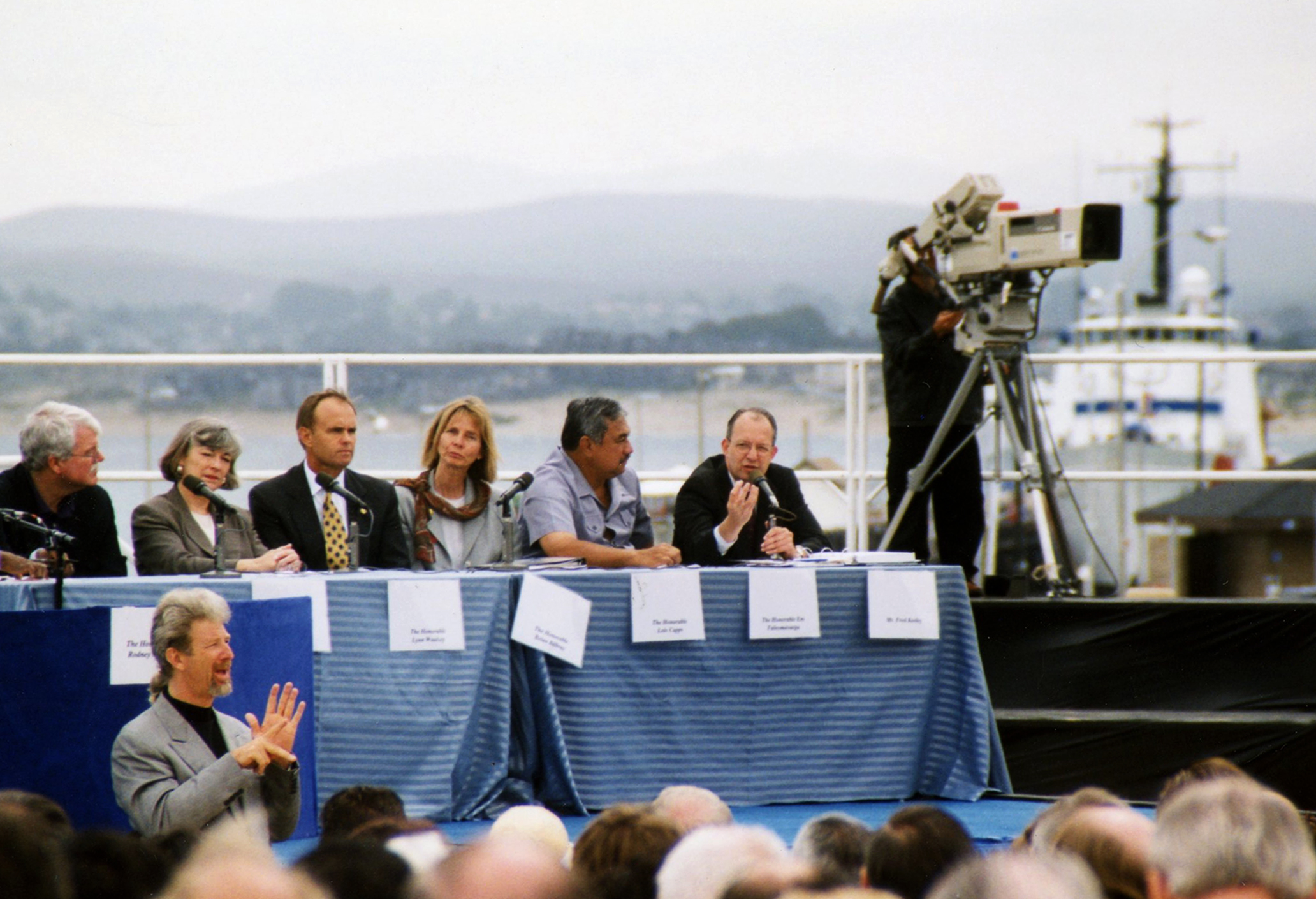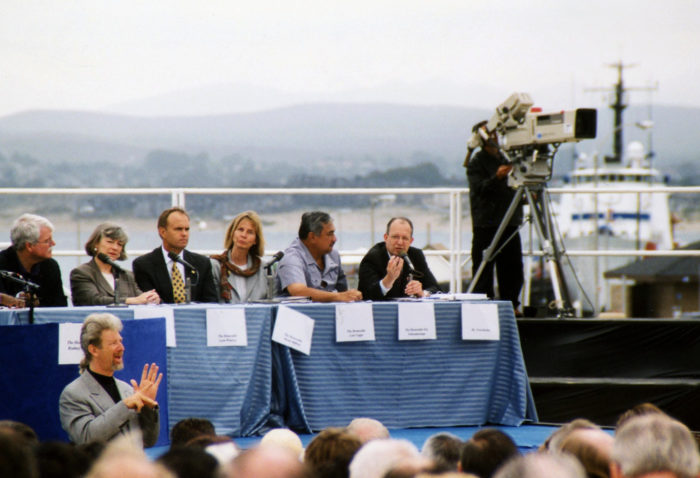
Sanctuary 30th Anniversary Series – Blog #8 “Finding sanctuary: From marine life abundance, to scarcity, to recovery ” by Fred Keeley
In previous articles in this series celebrating the 30th anniversary of the establishment of the Monterey Bay National Marine Sanctuary, you have been able to get an in-depth history of that massive undertaking. Ocean heroes Dan Haifley and Sam Farr have filled these pages with deep looks at the science, politics, and community-based organizing that resulted in this important designation.
More will follow when sanctuary superintendent Lisa Wooninck shares her thoughts concerning the sanctuary’s future while Leon Panetta will talk about the sanctuary’s formation.
In this edition, we will look at what doors were opened because of the sanctuary designation in 1993. To do so, we will back up a bit in California history.
For thousands of years, the Indigenous People of the Central Coast lived in harmony with this wonderfully bountiful area. Whether it was sustainable fishing, hunting in similar ways, or respecting the rhythms of nature in every way, the Indigenous People had a light touch on their environment. Tribal chairman Valentine Lopez often shares his intergenerational history of these peaceful and intelligent practices during his many speeches and lectures.
When, on Sept. 9, 1850, California joined the United States as a free, non-slave state, everything began to change. The 1849 Gold Rush was in full force and effect. Hydraulic mining (pointing high pressure water hoses at entire hillsides to flush gold into sloughs for separating gold from mud), was employed with little concern for anything but gold. On the coast, hundreds and then thousands of miners, prospectors, investors, merchants and more, poured into the San Francisco and Monterey Bay areas. The fishing and hunting were easy, as the schools of fish and the herds of deer were plentiful.
An initial component of California’s Constitution included establishment of the California Fish and Game Commission. There are virtually no other states that place a F&G commission in their constitutions. Primarily, the F&G function was as a revenue source from “hook and bullet” licenses. The issue at the time was “how to manage abundance,” and the action item was to do very little.
Moving into the mid-20th century, millions of people had made California their home, hundreds of thousands of new folks arrived every year. Nearly 70% of those new folks chose to live within an hour’s drive of the California coast. With very little active management of fish and game, the new challenge became how to manage scarcity, rather than abundance. Still, however, little to no action was taken to change from passive to active management of these important natural resources.
In 1969, the Santa Barbara oil spill awakened residents (and, perhaps more importantly, voters) throughout California to the dangers posed to marine life, human life, and water quality by continued exploitation of gas, oil and overfishing. Scientists, policy makers, local communities, and Indigenous peoples rallied to stop this out-of-control devastation of our public resources. While oil and gas drilling were the primary foci of grass-roots opposition, the less publicized loss of species and reduction of marine life in general was under serious study by ocean and marine scientists.
Some of the most respected and thoughtful marine scientists had already, by 1969, been studying this topic, and had reached several conclusions. For example, the Marine Life Research Group at Scripps Institute of Oceanography had been investigating the decline in ocean species since the late 1940s. By the late 1990s, these and other marine scientists had concluded that “If we are to establish sustainable use of (ocean) resources for the 21st century, the present status of many of our marine fisheries dictates that a major reorganization of the existing management structure is required.”
Other scientists, coastal-dependent agriculturalists, coastal-based visitor serving businesses, and local governments and voters were awakened to the need for major changes in ocean resource management. Local marine scientists, such as Pete Raimondi and Mark Carr at UC Santa Cruz, were among the leaders of the effort.
The work of these and other great scientific minds began to move from science to policy action. The Natural Resources Defense Council, the Sierra Club, the California Public Interest Research Group, the Center for Marine Conservation, the League for Coastal Protection, and the California League of Conservation Voters opened a dialogue with my office during my service in the California Assembly. The basic notion was, through landmark legislation, to completely change how marine resources in California’s coastal waters were managed. To move from passive to active management.
At the outset of this work to make significant management changes, some commercial and sport fishers were, at a minimum, skeptical. They were concerned that comprehensive management of fisheries would threaten their businesses. The Sportfishing Association of California and the Pacific Coast Federation of Fishers both expressed serious doubts.
When Assembly Bill 1240 “The Sea Life Recovery and Management Act” was introduced on Feb. 28, 1997, the negotiations on this public policy began in earnest. There was no disagreement that marine resources, especially fisheries, were in decline. There was, however, a spirited debate as to what to do about it. AB 1240 began to run the gauntlet of legislative process, and, at each step along the way, more and more clarity emerged as to that solution. In policy committees in both the Assembly and Senate, the bill moved closer and closer to consensus among the disputing parties. Through the amendment process, commercial fishers obtained important assurances that the fish stocks would be increased, rather than their livelihoods shut down.
Pietro Parravano, a multi-generational fisher out of Half Moon Bay, advanced provisions that “bring fishers into the fishery management process at all stages of the bill’s implementation.” From the other direction, the Natural Resources Defense Council was able to secure amendments that “declares the State’s general objective for marine management is to be conservation, restoration and sustainable use of healthy ecosystems”. The League for Coastal Protection wanted “a proactive approach to fisheries management based on sustainable management principles consistent with federal law. Preparation of scientifically sound comprehensive management plans will significantly improve fisheries in the State.” AB 1240 was amended to achieve these goals.
Certainly, the legislative process, which by design is iterative in nature, ends at a place that is not. It ends at the governor’s desk. In 1998, then-Gov. Pete Wilson, a Republican, was completing his second and final term as California’s chief executive. His administration had been lukewarm to AB 1240 during its winding path to his desk. In March 1997, however, Wilson and his Resources Secretary Douglas Wheeler had written, “A variety of coastal and ocean industries, including fishing, marine aquaculture, biotechnology, tourism, and recreation depend on the maintenance and enhancement of California’s ocean and coastal habitats and living resources. These resources, and the economic base they support, will benefit substantially from the development of a comprehensive program to sustain California’s ocean ecosystem into the 21st century and beyond.”
Seeing that there was a political opportunity to achieve landmark policy for our coast and oceans, we began a full court press on Wilson to sign AB 1240 into law. From throughout California, hundreds of organizations and individuals deluged the governor’s office with letters, calls and faxes, urging Wilson to keep his word from 1997.
On the final night to sign or veto legislation, Wilson signed AB 1240 into law, and the protection and enhancement of our coastal resources became a reality. None of this would have been possible had not the Monterey Bay National Marine Sanctuary been established and set forth as a model of cooperation and consensus for ocean protection.
In the next installment, we will look at whether or not the lofty goals of this major legislation have had the desired positive impact on our coast and ocean. Stay tuned.

Fred Keeley represented the Central Coast in the California Assembly from 1996 through 2002. He is a founding board member of the Monterey Bay National Marine Sanctuary Foundation. For more on the sanctuary’s 30th anniversary, go to montereybayfoundation.org.
About this series
Monterey Bay National Marine Sanctuary celebrates its 30th anniversary this fall, and the national sanctuary system celebrates its 50th. For the next 12 weeks, the Sentinel will publish columns by former U.S. Secretary of Defense Leon Panetta, along with Sam Farr, Dan Haifley, Fred Keeley, and Sanctuary Superintendent Dr. Lisa Wooninck. All of these contributors serve on the board of Monterey Bay National Marine Sanctuary Foundation and were involved with the Sanctuary’s designation.

